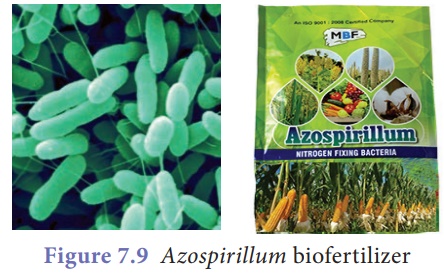Chapter: 9th Science : Economic Biology
Types of Biofertilizers
Biofertilizers
Biofertilizers are
substances that contain living microorganisms which, when applied to seeds,
plant surfaces, or soil, colonize the rhizosphere or the interior of the plant
and promote growth by increasing the supply or availability of primary
nutrients to the host plant.
Types
of Biofertilizers
Rhizobium
Rhizobium is a soil bacterium that
colonize the roots of leguminous plants to form root nodules. The
bacteria fix atmospheric nitrogen and convert them to ammonia.

Azospirillum
Azospirillum has the ability to use
atmospheric nitrogen and transport this nutrient to the crop plants. It is
inoculated on maize, barley, oats and sorghum crops. It increases productivity
of cereals by 5 - 20%, of millets by 30% and fodder by over 50%.

Azotobacter
Application of Azotobacter
has been found to increase yield of wheat, rice, maize and sorghum. Apart from
nitrogen fixation, these organisms are capable of producing antifungal and
antibacterial compounds.

Mycorrhizae
These fungi have
symbiotic association with the roots of vascular plants. They increase the
uptake of phosphorus. e.g. Citrus, Papaya.

Azolla
Azolla is a free floating,
aquatic fern found on water surfaces having a cyanobacterial symbiotic
association with Anabaena. It is a live floating nitrogen factory using
energy from photosynthesis to fix atmospheric nitrogen.

Related Topics